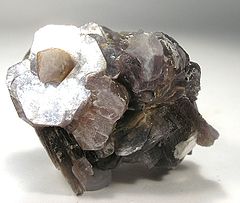Mica
| Mica | |
|---|---|

Mica (lepidolite variety)
|
|
| General | |
| Category | Mineral silicates |
|
Formula (repeating unit) |
AB2-3(X, Si)4O10(O, F, OH)2 |
| Identification | |
| Color | purple, rosy, silver, gray (lepidolite); dark green, brown, black (biotite); yellowish-brown, green white (phlogopite); colorless, transparent (muscovite) |
| Cleavage | perfect |
| Fracture | flaky |
| Mohs scale hardness | 2.5-4 (lepidolite); 2.5-3 biotite; 2.5-3 phlogopite; 2-2.5 muscovite |
| Luster | pearly, vitreous |
| Streak | White, colorless |
| Specific gravity | 2.8–3.1 |
| Melting point | 700–1000 °C |
| Diagnostic features | cleavage |
| References | |
The mica group of sheet silicate (phyllosilicate) minerals includes several closely related materials having nearly perfect basal cleavage. All are monoclinic, with a tendency towards pseudohexagonal crystals, and are similar in chemical composition. The nearly perfect cleavage, which is the most prominent characteristic of mica, is explained by the hexagonal sheet-like arrangement of its atoms.
The word mica is derived from the Latin word , meaning a crumb, and probably influenced by , to glitter.
Chemically, micas can be given the general formula
in which
Structurally, micas can be classed as dioctahedral (Y = 4) and trioctahedral (Y = 6). If the X ion is K or Na, the mica is a common mica, whereas if the X ion is Ca, the mica is classed as a brittle mica.
Common micas:
Brittle micas:
Very fine-grained micas, which typically show more variation in ion and water content, are informally termed "clay micas". They include:
Mica is widely distributed and occurs in igneous, metamorphic and sedimentary regimes. Large crystals of mica used for various applications are typically mined from granitic pegmatites.
Until the 19th century, large crystals of mica were quite rare and expensive as a result of the limited supply in Europe. However, their price dramatically dropped when large reserves were found and mined in Africa and South America during the early 19th century. The largest documented single crystal of mica (phlogopite) was found in Lacey Mine, Ontario, Canada; it measured 10 × 4.3 × 4.3 m and weighed about 330 tonnes. Similar-sized crystals were also found in Karelia, Russia.
...
Wikipedia
